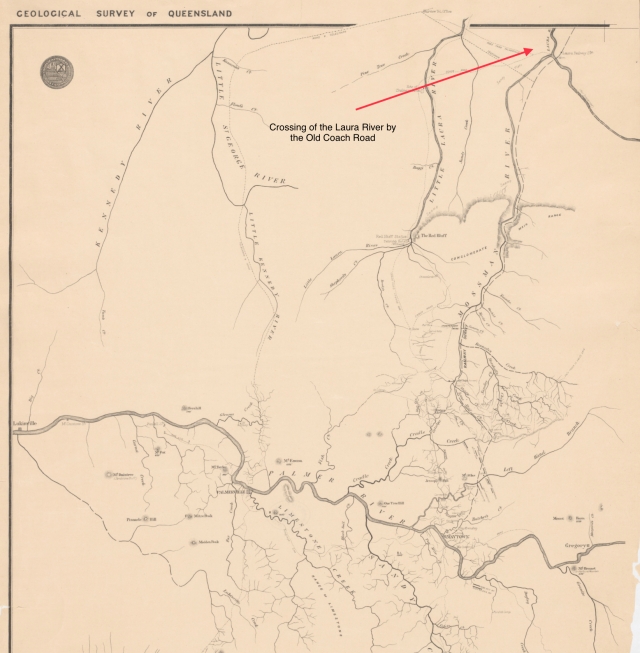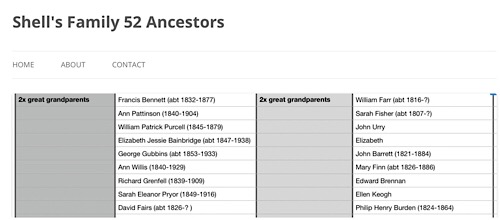Bob heard the roar of the water well before he saw it. Was this yet another barrier between his sick father and the Cooktown Hospital? Then, as Bob and the others approached the banks of the Laura River, the heavens opened. The men carried Jim the last few yards through a terrific downpour. He was lying on the stretcher Bob had found at the old, deserted hospital at Maytown. As if the rain wasn’t enough to dampen Bob’s spirits, his heart sank when his eyes confirmed what he’d heard. Sweet, gentle Laura, usually so quiet and placid, was filled with flooding water and awakened. Animated, she became an angry she-devil, gathering small trees and bushes in her arms to bring them along for the ride. How would she treat Jim when it was his turn on the water?
There was a short distance left to get to the Laura township, the other side of the river. It was the last section of their 52-mile trek from remote Maytown. Once there, Bob would telegraph Fred Schipke, the stationmaster at Cooktown, to bring a special train the 68 miles to Laura.
Despite being sick, it was the perseverance of James Watters, publican, businessman, former prospector and miner, that took him to Maytown. As the promoter of a syndicate of investors, Jim had secured permission from the Queensland government to lease 300 acres on the old Palmer River Goldfields. The syndicate guaranteed to spend at least £10,000 to explore the old mines, hoping to reopen the field. The mining companies abandoned reef mining on the field 30 years before, in the financial crisis of 1893. Too much capital was needed to pump the water from the mines, and the gold had petered out above a layer of shale. Jim, an experienced reefer, was convinced there was more gold below the shale.
Bob worried about his father. Although Jim’s fever had improved since Bob first saw him a week ago at Maytown, he complained about a stomach ailment. It was crucial Bob took him to hospital. They had left days ago and encountered rivers, rough tracks and two rugged ranges. Here was that she-devil Laura between them and the railway line of hope.
The rain cleared and Bob saw the four Aboriginal men with the bark boat Sergeant Wedderick had asked them to make if Bob attempted the crossing. The boat was formed from one large piece of bark, tied at the ends with rope. It looked flimsy and was smaller than the old tin boat they had repaired and used to take Jim across the Palmer River two days before. Bob rubbed his chin, took off his hat and ran his hands through his hair.
“Crikey, Sandy,” he said to his offsider, “I can’t see us getting Dad across in that.”
Bob doubted his decision to leave Maytown. He knew there had been enough rain to flood the river. They should have stayed put, instead of carrying Jim over rugged country for three days to have him drown so close to Laura Railway Station. He kicked at the wet ground. Everything was soaked. The men were soaked; the tents were soaked; the horses were soaked. His father was soaked. The rain gave temporary relief from the heat, but the oppressive tropical humidity stifled Bob. It cloaked his skin and hampered any cooling. He was desperate to fathom an answer to this predicament as the suffocating air perforated his brain. Should they put the tents up and wait for the river to recede? But the wet season had set in and Jim’s illness might worsen. Should they risk the crossing? Sandy interrupted his thoughts.
“Nah, she’ll be right, Bob. We’ll go downstream. The water will be quieter where the river deepens. And don’t worry about the boat. Those fellas know how to build them strong.” The sound of Sandy’s voice and his reply was the relief Bob was looking for.
He had worked with Sandy Connors before. Sandy was of mixed race, Aboriginal and Caucasian, and Bob had asked Sandy especially to go with him from Laura to Maytown. That man knew his way around the bush. He had grown up and worked with cattle and horses in this area all his life. Flooded rivers weren’t a big deal to him when cattle needed driving somewhere. If Sandy Connors said they could make the crossing, Bob trusted him. That was one thing Bob had learnt from his time at Gallipoli and the battlefields of France – you could rely on your mates.
“All right, let’s do this.”
Bob walked over to his father, who was lying on the stretcher where the men had left him. “We’re going to take you across the river, Dad.” Jim nodded with a smile and then grimaced as another cramp gripped his stomach.
Sandy approached the boat builders and Bob joined him. “Thanks, fellas,” he said with a smile as he shook their hands. Sandy spoke with them in their language and they carried the boat downstream.
“Can you bring Jim down here?” Sandy said to the stretcher bearers, raising his voice above the sound of the water. Grabbing the halter of a packhorse, he motioned them to follow. Four men lifted the stretcher and picked their way through the bush beside the rushing waters.
Sandy found a suitable launch place. He filled the boat with pack saddles and tents equal to a man’s weight and tested it on the water. The boat floated; no water swamped it. Sandy turned to Bob with a smile and a thumbs up gesture, then a wave to bring Jim. Bob helped his father to his feet, and Jim, holding his side, limped over, while the men unloaded the boat and held it steady in the shallows.
As Jim stepped into the boat and sat down, Bob thought about his mother and having to face her if something happened to Jim. His guilt was still raw, arriving home from the war when his brother hadn’t. Bob wanted to tell his father to get out, but Sandy had already moved the boat out into the current. Sandy swam behind, giving the boat a push now and again to guide its direction, some men swam alongside, downstream, in case of a capsize.
Bob walked along the bank to keep the boat and the swimmers in sight as the flooding waters forced them further away. His stomach churned, and his breath came in bursts. He watched helplessly as the men traversed the river, not knowing where they would land on the opposite bank, not knowing if they would land on the opposite bank.
Bob held his breath. The boat was nearly there, only a yard or two to go. A fallen tree reached out into the water and two figures swam ahead and pinned themselves against its leafy branches, reaching out towards the boat. Sandy manoeuvred the boat to them and they held it against the rush of water. All the men were suddenly there. Bob strained to see his father among the figures, and then he saw Jim pulled from the boat and on to the bank. Jim clambered a few yards and sat down. With great relief, Bob exhaled.

https://creativecommons.org/licenses/by-sa/3.0/

Bibliography
TO SAVE A LIFE. The Daily Mail (Brisbane, Qld. : 1903 – 1926) 13 March 1922: 6. from http://nla.gov.au/nla.news-article220521051
Jack, Robert L & Fox, W. H & Queensland. Geological Survey Office & Geological Survey of Queensland. (1896). Map of the Palmer district, retrieved from http://nla.gov.au/nla.obj-231419608






Pingback: Time to Shift up a Gear | Shelley's Family Histories and Mysteries
Great descriptive story – relieved they got Jim over the river ok
LikeLike
Glad you enjoyed the story.
LikeLike
I love the way you’ve brought that story to life
LikeLike
Thanks for stopping by, Caroline. I’m glad you enjoyed it.
LikeLike
Great story! I love the railway station photo.
LikeLike
Thanks for stopping by, Margaret.
LikeLike
Great storytelling! As a Laura, I particularly loved how you gave the river emotions. (Adding that to my bucket list of places to visit, too.)
LikeLike
Glad you liked it, Laura.
LikeLike
Pingback: The Crate | Shelley's Family Histories and Mysteries
Great story of Laura I am a descendant of John Thomas of Fairview and Olivevale Stations. My great grandfather worked on the building of the Telegraph from Fairview Station to the tip of the Cape. He married the daughter of John Thomas and worked as a linesman at Musgrave, Coen, and Fairview, then transferred to Rockhampton where he stayed until his death in 1920
LikeLike